Page 629 of 700
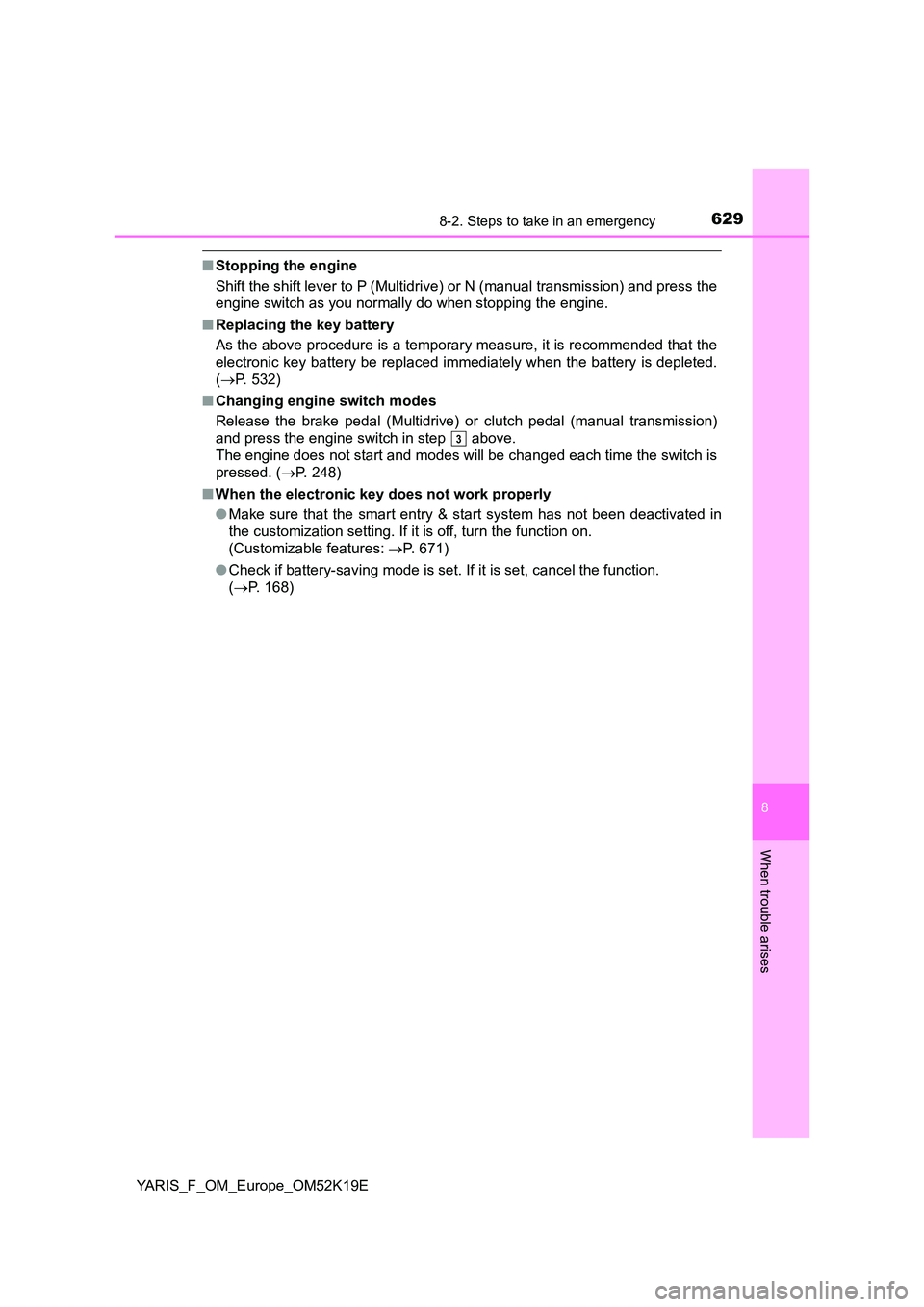
6298-2. Steps to take in an emergency
8
When trouble arises
YARIS_F_OM_Europe_OM52K19E
■Stopping the engine
Shift the shift lever to P (Multidrive) or N (manual transmission) and press the
engine switch as you normally do when stopping the engine.
■ Replacing the key battery
As the above procedure is a temporary measure, it is recommended that the
electronic key battery be replaced immediately when the battery is depleted.
( P. 532)
■ Changing engine switch modes
Release the brake pedal (Multidrive) or clutch pedal (manual transmission)
and press the engine switch in step above.
The engine does not start and modes will be changed each time the switch is
pressed. ( P. 248)
■ When the electronic key does not work properly
● Make sure that the smart entry & start system has not been deactivated in
the customization setting. If it is off, turn the function on.
(Customizable features: P. 671)
● Check if battery-saving mode is set. If it is set, cancel the function.
( P. 168)
3
Page 630 of 700
6308-2. Steps to take in an emergency
YARIS_F_OM_Europe_OM52K19E
If the vehicle battery is discharged
If you have a set of jumper (or booster) cables and a second vehicle
with a 12-volt battery, you can jump start your vehicle by following the
steps below.
Open the hood. ( P. 483)
Connect the jumper cables according to the following procedure:
1KR-FE engine
The following procedures may be used to start the engine if the
vehicle’s battery is discharged.
You can also call any authorized Toyota retailer or Toyota autho-
rized repairer, or any reliable repairer.
1
2
Page 631 of 700
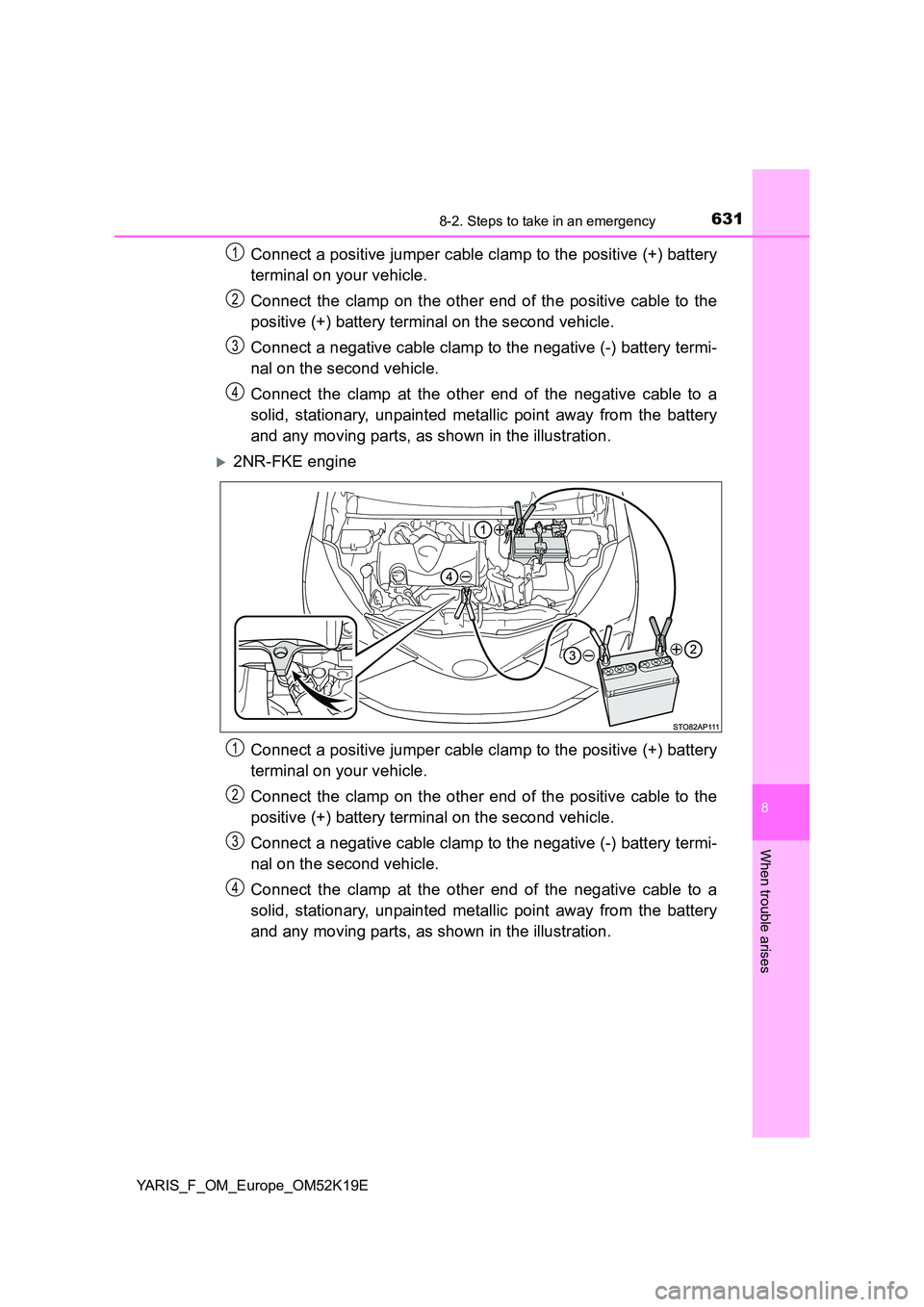
6318-2. Steps to take in an emergency
8
When trouble arises
YARIS_F_OM_Europe_OM52K19E
Connect a positive jumper cable clamp to the positive (+) battery
terminal on your vehicle.
Connect the clamp on the other end of the positive cable to the
positive (+) battery terminal on the second vehicle.
Connect a negative cable clamp to the negative (-) battery termi-
nal on the second vehicle.
Connect the clamp at the other end of the negative cable to a
solid, stationary, unpainted metallic point away from the battery
and any moving parts, as shown in the illustration.
2NR-FKE engine
Connect a positive jumper cable clamp to the positive (+) battery
terminal on your vehicle.
Connect the clamp on the other end of the positive cable to the
positive (+) battery terminal on the second vehicle.
Connect a negative cable clamp to the negative (-) battery termi-
nal on the second vehicle.
Connect the clamp at the other end of the negative cable to a
solid, stationary, unpainted metallic point away from the battery
and any moving parts, as shown in the illustration.
1
2
3
4
1
2
3
4
Page 632 of 700
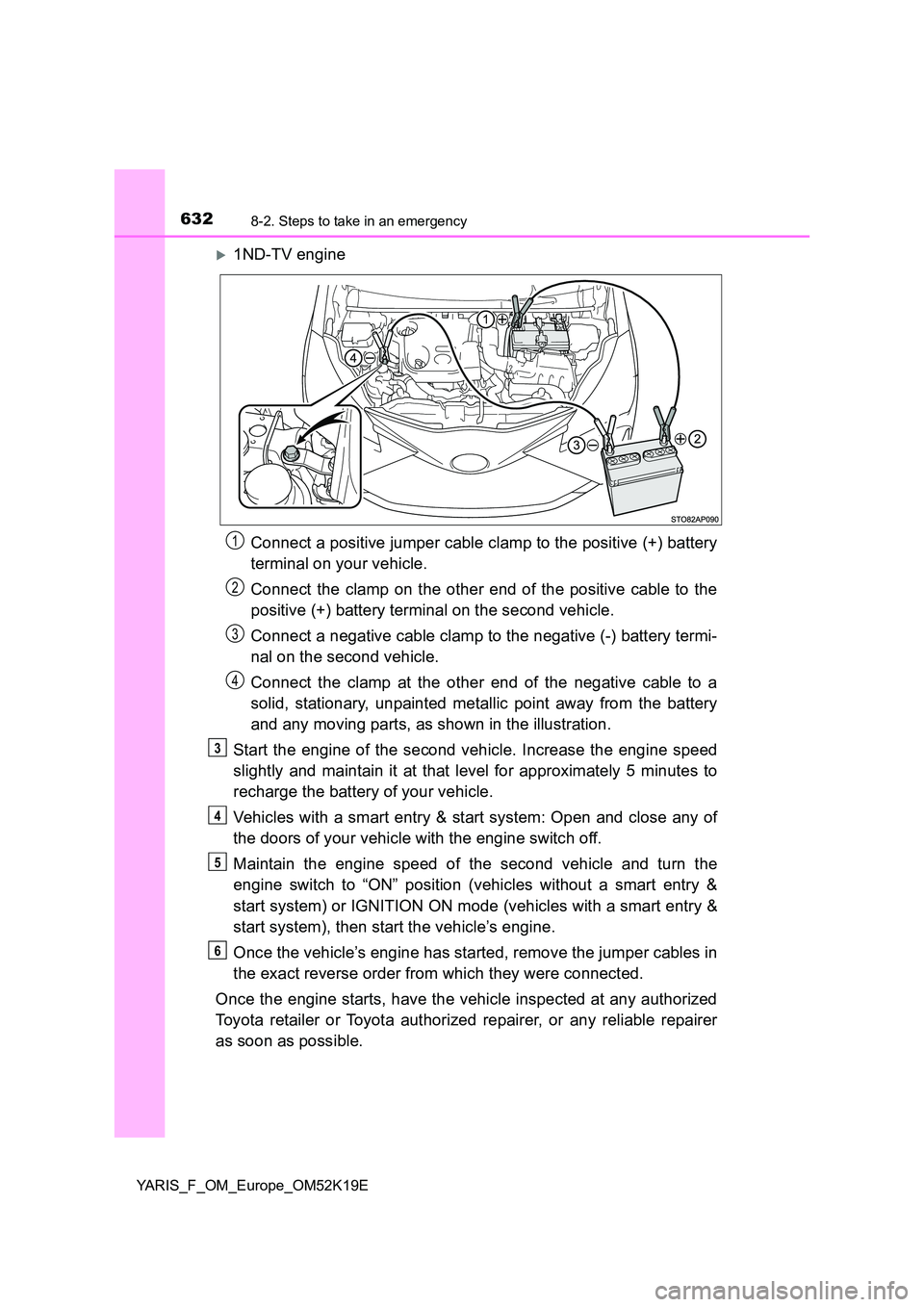
6328-2. Steps to take in an emergency
YARIS_F_OM_Europe_OM52K19E
1ND-TV engine
Connect a positive jumper cable clamp to the positive (+) battery
terminal on your vehicle.
Connect the clamp on the other end of the positive cable to the
positive (+) battery terminal on the second vehicle.
Connect a negative cable clamp to the negative (-) battery termi-
nal on the second vehicle.
Connect the clamp at the other end of the negative cable to a
solid, stationary, unpainted metallic point away from the battery
and any moving parts, as shown in the illustration.
Start the engine of the second vehicle. Increase the engine speed
slightly and maintain it at that level for approximately 5 minutes to
recharge the battery of your vehicle.
Vehicles with a smart entry & start system: Open and close any of
the doors of your vehicle with the engine switch off.
Maintain the engine speed of the second vehicle and turn the
engine switch to “ON” position (vehicles without a smart entry &
start system) or IGNITION ON mode (vehicles with a smart entry &
start system), then start the vehicle’s engine.
Once the vehicle’s engine has started, remove the jumper cables in
the exact reverse order from which they were connected.
Once the engine starts, have the vehicle inspected at any authorized
Toyota retailer or Toyota authorized repairer, or any reliable repairer
as soon as possible.
1
2
3
4
3
4
5
6
Page 633 of 700
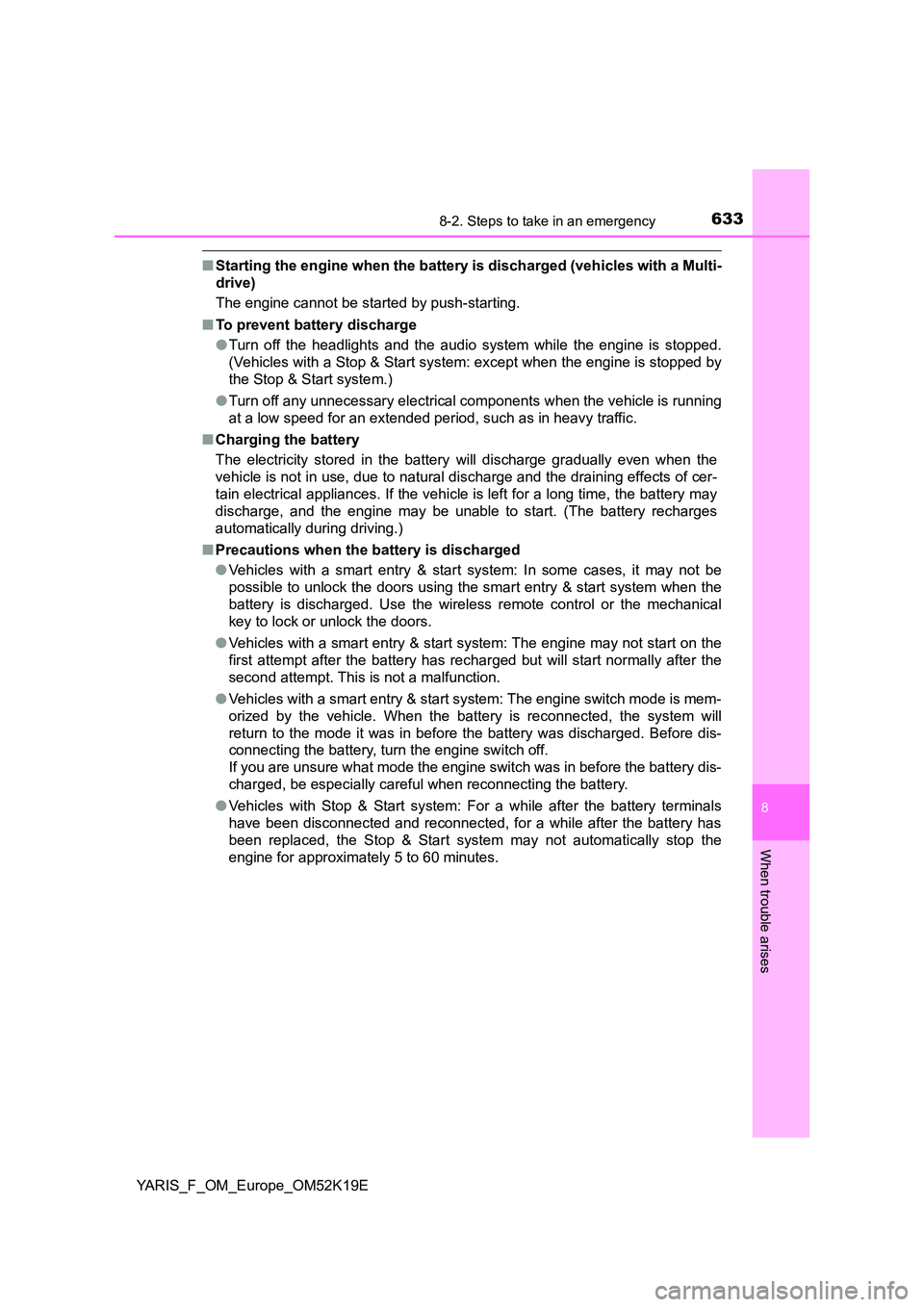
6338-2. Steps to take in an emergency
8
When trouble arises
YARIS_F_OM_Europe_OM52K19E
■Starting the engine when the battery is discharged (vehicles with a Multi-
drive)
The engine cannot be started by push-starting.
■ To prevent battery discharge
● Turn off the headlights and the audio system while the engine is stopped.
(Vehicles with a Stop & Start system: except when the engine is stopped by
the Stop & Start system.)
● Turn off any unnecessary electrical components when the vehicle is running
at a low speed for an extended period, such as in heavy traffic.
■ Charging the battery
The electricity stored in the battery will discharge gradually even when the
vehicle is not in use, due to natural discharge and the draining effects of cer-
tain electrical appliances. If the vehicle is left for a long time, the battery may
discharge, and the engine may be unable to start. (The battery recharges
automatically during driving.)
■ Precautions when the battery is discharged
● Vehicles with a smart entry & start system: In some cases, it may not be
possible to unlock the doors using the smart entry & start system when the
battery is discharged. Use the wireless remote control or the mechanical
key to lock or unlock the doors.
● Vehicles with a smart entry & start system: The engine may not start on the
first attempt after the battery has recharged but will start normally after the
second attempt. This is not a malfunction.
● Vehicles with a smart entry & start system: The engine switch mode is mem-
orized by the vehicle. When the battery is reconnected, the system will
return to the mode it was in before the battery was discharged. Before dis-
connecting the battery, turn the engine switch off.
If you are unsure what mode the engine switch was in before the battery dis-
charged, be especially careful when reconnecting the battery.
● Vehicles with Stop & Start system: For a while after the battery terminals
have been disconnected and reconnected, for a while after the battery has
been replaced, the Stop & Start system may not automatically stop the
engine for approximately 5 to 60 minutes.
Page 634 of 700
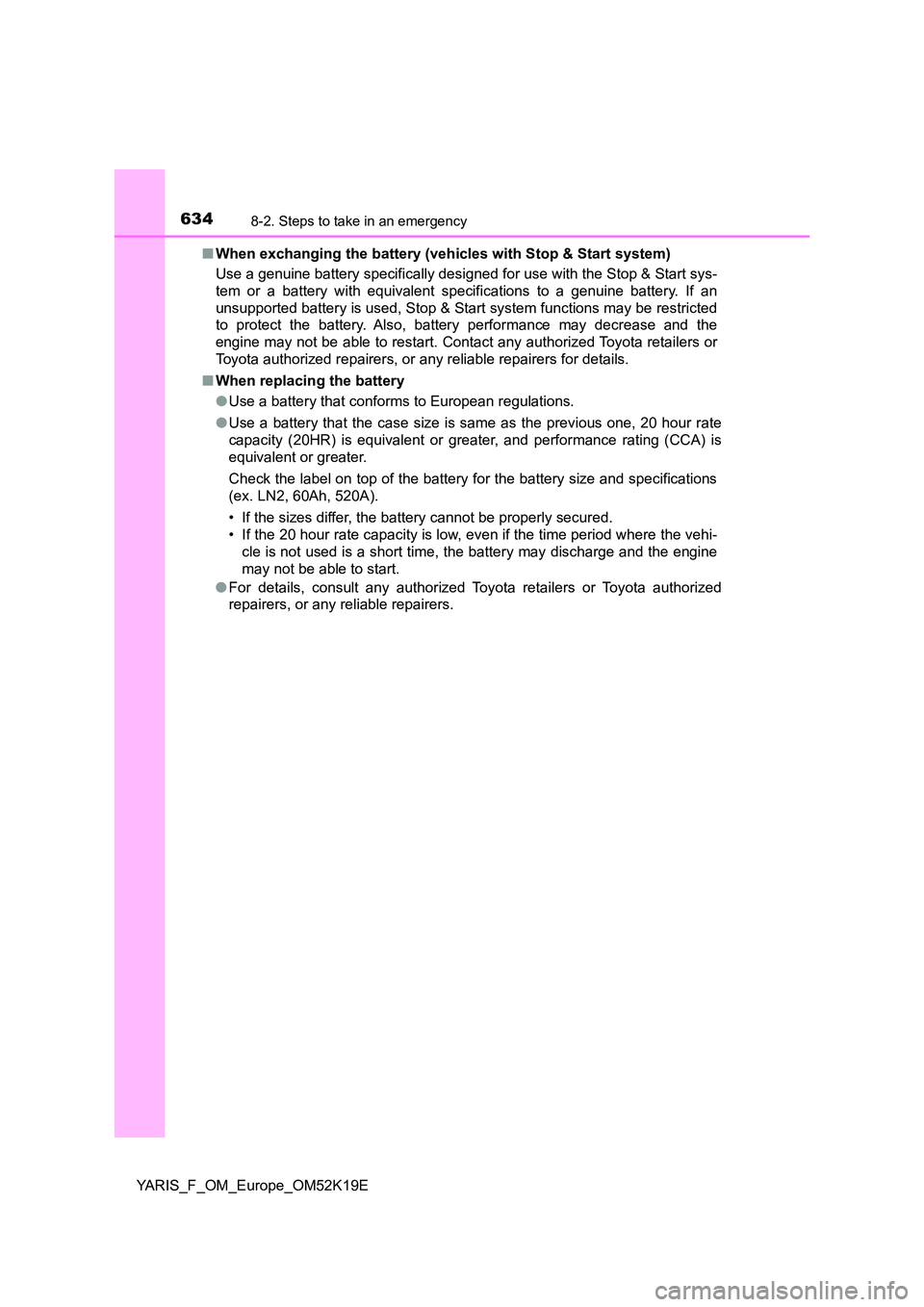
6348-2. Steps to take in an emergency
YARIS_F_OM_Europe_OM52K19E
■ When exchanging the battery (vehicles with Stop & Start system)
Use a genuine battery specifically designed for use with the Stop & Start sys-
tem or a battery with equivalent specifications to a genuine battery. If an
unsupported battery is used, Stop & Start system functions may be restricted
to protect the battery. Also, battery performance may decrease and the
engine may not be able to restart. Contact any authorized Toyota retailers or
Toyota authorized repairers, or any reliable repairers for details.
■ When replacing the battery
● Use a battery that conforms to European regulations.
● Use a battery that the case size is same as the previous one, 20 hour rate
capacity (20HR) is equivalent or greater, and performance rating (CCA) is
equivalent or greater.
Check the label on top of the battery for the battery size and specifications
(ex. LN2, 60Ah, 520A).
• If the sizes differ, the battery cannot be properly secured.
• If the 20 hour rate capacity is low, even if the time period where the vehi-
cle is not used is a short time, the battery may discharge and the engine
may not be able to start.
● For details, consult any authorized Toyota retailers or Toyota authorized
repairers, or any reliable repairers.
Page 635 of 700
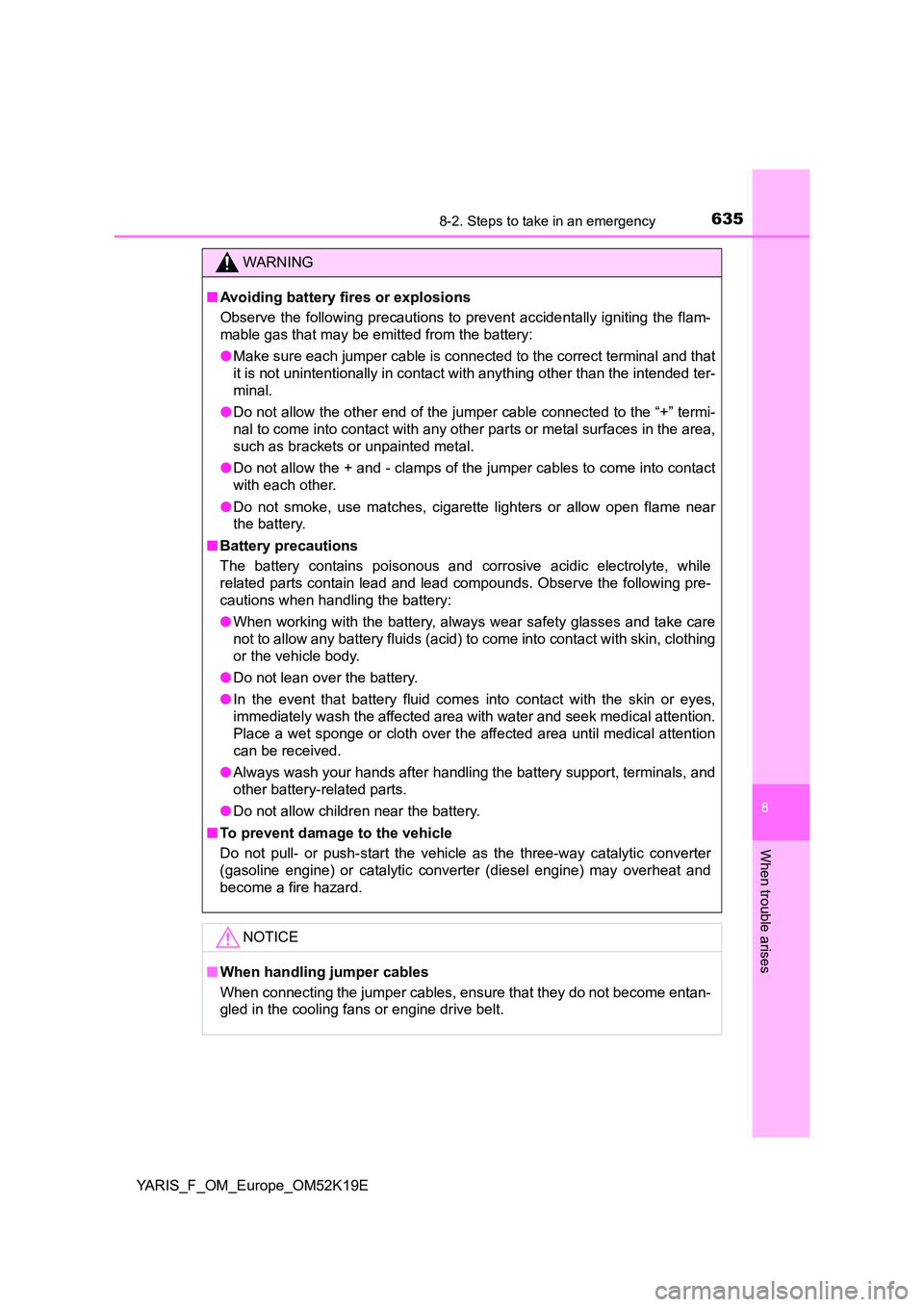
6358-2. Steps to take in an emergency
8
When trouble arises
YARIS_F_OM_Europe_OM52K19E
WARNING
■Avoiding battery fires or explosions
Observe the following precautions to prevent accidentally igniting the flam-
mable gas that may be emitted from the battery:
● Make sure each jumper cable is connected to the correct terminal and that
it is not unintentionally in contact with anything other than the intended ter-
minal.
● Do not allow the other end of the jumper cable connected to the “+” termi-
nal to come into contact with any other parts or metal surfaces in the area,
such as brackets or unpainted metal.
● Do not allow the + and - clamps of the jumper cables to come into contact
with each other.
● Do not smoke, use matches, cigarette lighters or allow open flame near
the battery.
■ Battery precautions
The battery contains poisonous and corrosive acidic electrolyte, while
related parts contain lead and lead compounds. Observe the following pre-
cautions when handling the battery:
● When working with the battery, always wear safety glasses and take care
not to allow any battery fluids (acid) to come into contact with skin, clothing
or the vehicle body.
● Do not lean over the battery.
● In the event that battery fluid comes into contact with the skin or eyes,
immediately wash the affected area with water and seek medical attention.
Place a wet sponge or cloth over the affected area until medical attention
can be received.
● Always wash your hands after handling the battery support, terminals, and
other battery-related parts.
● Do not allow children near the battery.
■ To prevent damage to the vehicle
Do not pull- or push-start the vehicle as the three-way catalytic converter
(gasoline engine) or catalytic converter (diesel engine) may overheat and
become a fire hazard.
NOTICE
■ When handling jumper cables
When connecting the jumper cables, ensure that they do not become entan-
gled in the cooling fans or engine drive belt.
Page 660 of 700

6609-1. Specifications
YARIS_F_OM_Europe_OM52K19E
*: The fluid capacity is the reference quantity. If replacement is necessary,
contact any authorized Toyota retailer or Toyota authorized repairer, or any
reliable repairer.
Ignition system (gasoline engine only)
Spark plug
MakeDENSO FC16HR-Q8
Gap0.8 mm (0.031 in.)
NOTICE
■ Iridium-tipped spark plugs
Use only iridium-tipped spark plugs. Do not adjust the spark plug gap.
Electrical system
Battery
Open voltage* at 20 C
(68 F):
12.3 V or higher
If the specific voltage is lower than the standard
value, charge the battery.
(*: Voltage is checked 20 minutes after the
engine and all lights are turned off.)
Charging rates 5 A max.
Multidrive
Fluid capacity*7.5 L (7.9 qt., 6.6 Imp.qt.)
Fluid typeToyota Genuine CVT Fluid FE
NOTICE
■ Multidrive fluid type
Using Multidrive fluid other than “T oyota Genuine CVT Fluid FE” may cause
deterioration in shift quality, locking up of your transmission accompanied
by vibration, and ultimately damage the transmission of your vehicle.